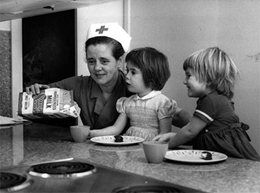Canadian Red Cross stresses need to protect humanitarian workers after record number of deaths
Read More

The First World War marked a major turning point for the Canadian Red Cross Society (CRCS), establishing it as Canada’s leading wartime humanitarian aid organization. From the moment the war broke out in August 1914, Canadians were keen and enthusiastic supporters of Red Cross work. The number of Red Cross branches (with official charters) and Red Cross auxiliaries (church groups, clubs, etc. who worked for a local Red Cross branch) across the country exploded, and financial donations flooded in. Women – who were not allowed to participate in the military at this time – were especially active in their support for the Red Cross, and the knitted “comforts” (socks, scarves, sweaters, etc.) and medical supplies (ex. Bandages) they produced by the millions became a symbol of women’s contributions in wartime. As Superintendent of Supplies, Mrs. Adelaide Plumptre brought a business-like efficiency to women’s wartime production. Volunteers also packed food parcels for Prisoners of War, and by the end of the war volunteers were also producing jam and other canned foods for invalid soldiers overseas. The Society donated large sums of money to the relief work of other Red Cross societies, and at the end of the war, to the cause of civilian refugees returning to devastated areas of Europe.
While Canadians fundraised and produced comforts and medical supplies back home, the Society set up overseas headquarters in London, England, from which to coordinate its work in Britain and France. This work encompassed the establishment and support of a number of rest homes and hospitals in England (including, most famously, the Taplow hospital on the Astor family’s Cliveden estate) and the provision of comforts and supplementary medical supplies to Canadian, British, French, and other allied hospitals. CRC volunteers visited convalescing soldiers in Britain, attempted to trace missing soldiers, maintained files on all Canadian Prisoners of War (with the assistance of the ICRC), and corresponded with family members in Canada about the status of their sick, wounded, missing, or captured loved ones. A separate but related CRC relief effort took place when Canadian and other allied troops were sent to Siberia in 1918. All of these activities took place in close cooperation with the British Red Cross (still the CRCS’s “parent” Society, at this time), but the Canadian Red Cross Society gained valuable experience and confidence over the course of the war. It also solidified its positive relationship with Canadians: the Society offered them a variety of concrete means of helping sick, wounded, and captured soldiers.
Sources:
CRCS. Annual Reports. 1914-1918.
Glassford, Sarah Carlene. “Marching As to War: The Canadian Red Cross Society, 1885-1939.” PhD dissertation, York University, 2007.
Read More
Read More
Read More